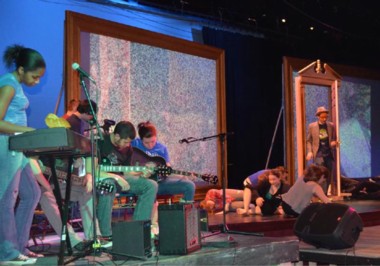The Grey Goo Theory imagines the world ending, not in fire or ice, but in a global cancer of self-replicating nanotechnology that ultimately devours the biosphere. The idea has morphed into an omnibus term deploring the insidious penetration of digital technology into every aspect of our lives, consuming our time and attention at the expense of flesh-and-blood human connections.
At Springfield College this weekend, technology meets humanity in How to Survive the Grey Goo, a cross-platform happening that fuses age-old theater forms and 21st-century media to critique and transcend “our hyper-stimulated, meme-driven, instant fame/instant shame culture.” (Info at springfieldcollege.edu/simpson or (13-748-3443.) The piece, described as “a live plus digital, interactive, multimedia performance event,” deploys a student cast of actors, digital and computer artists, musicians, writers, dancers, videographers, designers “and communicators of all stripes.”
Material was generated in an interdisciplinary arts course from three sources—current digital and social media culture, age-old stories and legends, and the students’ own lives and dreams. Live music, mask sequences, dances, shadow-play and storytelling interact with films, animations and live manipulation of media, both pre-planned and improvisational.
As the show’s director, Martin Shell, observes, “It’s been pretty easy to detect the rising anxiety students are experiencing around being both enthralled and somewhat enslaved by their digital media. We’ve put this into focus by playing with it. We’re experimenting with real people in real time and real space, finding every way we can to use the technological tools of communication to make things that are familiar to us. Through the channels of performance, [the student-generated material] meets up with some of the natural human wisdom that is coded into some ancient fables. Storytelling is how we learn about who we are, how we join the community of others, and how we discover ways to recognize and manipulate the patterns of experience.”
*
Ancient themes also collide with present-day realities this weekend in Hampshire College’s first-ever Fringe Festival of “cutting-edge, socially relevant performances.” (Info at theatre.hampshire.edu, 413-559-5351.) Connecting the five pieces, says festival coordinator Matt Haley, is the idea of “theater as a vehicle for social action.” The plays deal, respectively, with issues of “reproductive justice, feminism and its relationship to fairytales, the teenage struggle for identity, Indian political oppression and queer family-making.”
Haley characterizes the festival as “intersectionality in action,” referring to the theory that overlapping systems of oppression (racism, sexism, classism, homophobia, etc.) are inextricably connected and cannot be understood—or combated—independently. “Just as intersectionality seeks to acknowledge interconnecting oppressions, the festival explores related injustices through the shared medium of theater.”
What visiting professor Talya Kingston describes as “a remarkable year of graduating theater concentrators” is further represented in a kaleidoscope of seniors’ thesis shows at Hampshire this month. GennaRose Nethercott’s folklore-inspired Ghostmaker combines performance poetry and shadow puppetry. While We See the Sun is “a queer fantasia variety show” by Sam Congdon. Courtney Price adapts Lewis Carroll’s Through the Looking-glass and What Alice Found There as a perambulating audience-participation experience. The Yiddish Book Center, on the Hampshire campus, hosts two more new plays. Stella Dreams of Trains, by Joanna Rosenberg, visits a mother and daughter in wartime Berlin and present-day Tel Aviv, and Moyshe Pupik and the Cookie Jar Giraffe is a multilingual musical by Ben Batchelder inspired by Sholem Aleichem.•
Contact Chris Rohmann at StageStruck@crocker.com.



